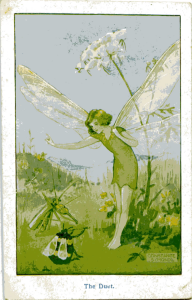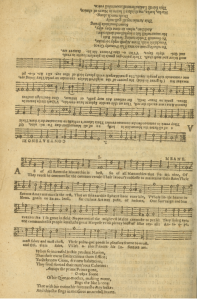By: Jim Thompson
I hope that you will like a postcard from my collection entitled The Duet. It shows a fairy princess conducting the music made by a bee on a piccolo and a grasshopper on a violin.
Of course we all know that this could never happen in real life, but did you know that Charles Butler, an English minister, logician, grammarist, musicologist and beekeeper that lived from 1560 to 1647 wrote a book called Feminine Monarchie in 1609? It was revised in 1623 and 1634. There were several errors that he corrected in beekeeping mentioned in his book. One – Aristotle said that the bees in the hive were led by a “King Bee” and Charles Butler identified the bee as the Queen Bee. Two – Butler observed that damaged bees secrete an alarm pheromone which leads other bees to sting. Three – he observed that bees produce beeswax rather than collecting it from plants. Four – he transcribed bee sounds into musical notes. From the tone pitch of the buzzing bees, one might be able to tell when swarming is going to happen. Another tonal discovery was the difference between piping, quacking or tooting. These scores appear on pages 78 to 81 of his 1623 book and are written for four voices: Meane (soprano), Tenor, Bassus and Countertenor. You will find two of them on one side of the page facing each other and the other two parts on the adjoining page so the four singers could be positioned around the book and see their parts.
 I saw once an account of the difficulties that Butler had in adjusting the tone and frequency of the notes, and was unable to find it again. But he found that it was in the key of G minor or C.
I saw once an account of the difficulties that Butler had in adjusting the tone and frequency of the notes, and was unable to find it again. But he found that it was in the key of G minor or C.
When you think of it, honey bees don’t have a larynx so they have to make noises by using their thorax and wings causing a vibration which can be heard. Oops, honey bees don’t have ears either, so the vibrations are picked up by the fifth segment of their antenna.
When a queen is about ready to emerge from her cell, she makes a noise called piping. A queen that is already in the hive may answer the piping with a sound called quacking or tooting. It is a way for the emerged queen to locate and kill the rival queen while she is in her cell. The beekeeper may look at the queen cells in a hive and tell whether the queen has emerged or was killed. If the queen cell has a trap door open, the queen emerged and if the queen cell has openings along the side of the cell, the queen has been killed.
You may be near the hive and hear the noise of the bees planning to swarm. I don’t remember hearing that sound, but I remember the old saying that when a swarm is in the air, you can get them to land by beating on a pan. Oh, what advice is given! Run in the house and get a pan and something to beat on it, hurry back outside near the swarm, chase after the swarm while beating the pan like crazy, and guess what? The swarm eventually lands. See it works and you had to only travel two blocks.
Bees must think that you understand them. Have you ever stood in the flight path of a honey bee? The first thing that she does is bump into you and you think “What is wrong with these bees, are they blind?” Your second warning is a bee buzzing right in front of your nose and mouth. Why there? Because she has detected that you are alive and breathing by the carbon dioxide that you are exhaling. Now you should step aside for there isn’t a third warning.
Bees communicate with each other by doing such things as a waggle dance and a round dance. These dances tell the other bees where the nectar is in relation to the hive. If you have seen these dances preformed, did you notice the bees close to the dancer are touching her with their antenna?
A study done by Lilach Hadany of Tel Aviv University states that plants hearing the buzzing of the low frequency sound of bees can increase the sugar content of their nectar 12-20%. This increase occurs within three minutes after the buzzing. I wonder if the bee waits until the richer nectar arrives or if it is meant for other bees or creatures. I also didn’t know plants could hear, but I know people talk to their plants. However, I wonder if there are any other studies like this one and how long the rich nectar is viable?
There are studies showing that plants feel pain such as cutting and smashing, but since the plants do not have a central nervous system, they react from vibrations.
There are several others that have used music while working with bees such as Dr. C.C. Miller, George York, Dr. Walter Rothenbuler, Dr. Norman Gary and others.
Dr. Charles C. Miller, June 10, 1831-September 4, 1920, taught singing school while going through school. When he was first married, he taught voice and instrumental music before becoming a high school principal. His fingering procedure on the piano was different from the normal practice, but soon was adapted by many. He teamed up with Eugene Secor of Iowa and wrote many bee songs. These songs were compiled and printed by George W. York as a pamphlet Songs of Beedom. He had an excellent singing voice and sang at the Marengo Opera House between 1883 and 1914. At the International American Bee Keeping Association, he performed a few of his bee songs including “Dot Happy Bee Man” and “The Bee-Keeper’s Reunion Song.”
Dr. Walter C. Rothenbuhler, 1920-2002, and Victor C. Thompson, 1920-2012, were known for the genetics of AFB resistance and hygienic behavior of honey bee stock. When they were teaching at Ohio State University they would occasionally play music to their students.
Dr. Norman Gary served on the University of Davis entomology faculty from 1962-1994. Thus he is known as being a professor, bee research scientist, musician and professional bee wrangler. For more than 65 years he performed in many bands playing clarinet, alto sax, tenor sax or flute. The last group, Beez Kneez, disbanded October 17, 2004.
Most of you know a song that has the word bee in the title as I found fifty of them. But did you know that the song “Flight of the Bumble Bee” ended up as a contest of how fast one could play it?
References:
C C Miller – Wikipedia.pdf
Israeli scientists find a flower they say can hear approaching bees
List of 50+ Songs With Bee in the Title…
The ‘piping’ and ‘quacking’ of queen bees – Moir Rare Book Collections – Nation






